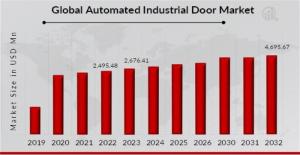Automated Industrial Door Market to hit USD 4,695.67 Million by 2032 with 7.28% CAGR | Maviflex, Novoferm GmbH, HDS
Automated Industrial Door Market grows with demand for safety, efficiency, and smart access in industrial facilities.
Automated Industrial Door Market a Comprehensive Analysis
The automated industrial door market has witnessed significant growth over the past few years, driven by technological advancements, increased demand for enhanced security, and the need for operational efficiency across various industrial sectors. Automated industrial doors, which are powered by electromechanical or hydraulic systems, are widely used in warehouses, manufacturing units, transportation hubs, and logistics centers. These doors offer numerous benefits such as improved workflow, energy efficiency, safety, and ease of access, making them an indispensable part of modern industrial infrastructure.
Automated industrial doors are specialized entry solutions designed to offer quick and secure access to buildings and restricted areas in industrial settings. These doors are commonly found in sectors like automotive, aerospace, pharmaceuticals, food and beverages, and chemicals, where they help regulate traffic, maintain temperature control, and prevent unauthorized access.
Get Free Sample PDF Brochure: https://www.marketresearchfuture.com/sample_request/5143
Key Companies in the Automated Industrial Door Market include.
Assa Abloy AB
Hart Door Systems
Gandhi Automations Pvt Ltd
AI-Barrack Industrial Group
Maviflex
RTJ Automation & Maintenance Limited
Gilgen Door Systems AG
Novoferm GmbH
Casit Srl Turin
Market Trends Highlights
Several key trends are shaping the automated industrial door market. One of the most prominent trends is the integration of smart technologies. Companies are increasingly incorporating features such as motion sensors, RFID readers, wireless communication, and predictive maintenance into their automated door systems. These features enhance user convenience, optimize maintenance schedules, and reduce operational downtime. Another major trend is the growing emphasis on energy efficiency. Industrial doors that open and close quickly help in maintaining indoor temperatures, especially in climate-sensitive environments like cold storage facilities and cleanrooms.
Additionally, the market is witnessing rising demand for customized solutions tailored to specific industrial applications. Manufacturers are offering doors with specialized materials, sizes, and automation capabilities to meet industry-specific needs. The emergence of sustainable and eco-friendly doors, made from recyclable materials and energy-efficient mechanisms, also marks a growing trend in line with global environmental regulations.
Market Dynamics
The automated industrial door market is dynamic and influenced by several interconnected factors. The rising need for efficient material handling, increased awareness of workplace safety, and advancements in building automation systems are key contributors to market growth. Industries are under pressure to optimize their supply chains and reduce energy consumption, both of which can be addressed through the implementation of automated doors. Moreover, government regulations mandating safety and accessibility standards in industrial environments further fuel market demand.
However, the market also faces challenges, such as the high installation and maintenance costs associated with advanced automated systems. Small and medium enterprises (SMEs), in particular, may find it difficult to allocate significant budgets for the installation of sophisticated doors. Additionally, technical complexities and downtime risks associated with automation systems could hinder adoption in some regions. Nonetheless, technological innovations and the emergence of cost-effective solutions are likely to mitigate these restraints in the long term.
Buy Now Premium Research Report: https://www.marketresearchfuture.com/checkout?currency=one_user-USD&report_id=5143
Market Drivers
One of the primary drivers of the automated industrial door market is the increasing focus on workplace safety and security. Industrial environments are prone to accidents and unauthorized access, and automated doors help reduce these risks by providing controlled access and minimizing manual handling. The rising prevalence of automation and robotics in industrial facilities is also driving the need for compatible infrastructure, including automated doors that can seamlessly integrate with automated workflows.
The growth of e-commerce and the logistics sector has further spurred demand for automated industrial doors, especially in warehouses and distribution centers. Fast-paced logistics operations require doors that can open and close rapidly and reliably, ensuring smooth and secure movement of goods. Additionally, urbanization and industrialization, particularly in developing economies, are leading to increased construction of industrial facilities, which in turn boosts the need for modern access solutions.
Market Restraints
Despite the numerous growth opportunities, the market is not without its constraints. The high initial cost of automated doors market remains a significant barrier, especially for budget-conscious industries and smaller organizations. While these doors offer long-term savings in energy and labor costs, the upfront investment required for automation technology, installation, and customization can be substantial.
Moreover, technological complexity and maintenance requirements pose challenges. Automated doors rely on a range of mechanical and electronic components that must function seamlessly. Any malfunction in the sensors, motors, or control systems can lead to operational delays and increased maintenance costs. In areas with limited access to skilled technicians or spare parts, such issues can escalate, affecting the reliability and attractiveness of these systems.
Automated Industrial Door Market Segmentation:
Global Automated Industrial Door Type Outlook
Sliding Door
Sectional overhead doors
Rapid roll doors
Folding hangar doors
Others
Global Automated Industrial Door Component Outlook
Operators Sensors & Detectors
Radar Movement Sensors
Pressure Sensors
Optical Sensors
Infrared Sensors
Passive Infrared Movement Sensors
Active Infrared Sensors
Access Control Systems
Motors & Actuators
Control Panels Switches
Others
Global Automated Industrial Door Sensor Mounting Outlook
Ceiling Mount
Transom Mount
Global Automated Industrial Door End-Use Outlook
Warehouse & distribution buildings
Factories & Manufacturing Facilities
Others
Global Automated Industrial Door Distribution Channel Outlook
Direct
Indirect
Browse In-depth Market Research Report: https://www.marketresearchfuture.com/reports/automated-industrial-door-market-5143
Regional Analysis
Geographically, the automated industrial door market is segmented into North America, Europe, Asia-Pacific (APAC), Latin America, and the Middle East & Africa.
North America leads the market owing to the high adoption of advanced technologies and automation across industrial sectors. The presence of major manufacturers and a strong logistics infrastructure also contribute to regional dominance. The United States, in particular, has a mature market with steady demand from warehouses and distribution centers.
Europe follows closely, with countries like Germany, the UK, and France being early adopters of automated industrial solutions. Stringent safety and energy efficiency regulations in the region have driven industries to adopt automated doors as part of their compliance strategies.
The Asia-Pacific region is expected to witness the fastest growth during the forecast period, propelled by rapid industrialization, urban development, and expansion of the e-commerce sector in countries such as China, India, Japan, and South Korea. Investments in smart infrastructure and manufacturing plants in APAC are also boosting demand for automated access systems.
Latin America and the Middle East & Africa are emerging markets with potential for growth, especially in regions experiencing infrastructure modernization and industrial expansion. Government initiatives to improve transportation and logistics networks are expected to support market development in these areas.
More Related Reports:
Water Electrolysis Market: https://www.marketresearchfuture.com/reports/water-electrolysis-market-4133
Industrial Dust Collector Market: https://www.marketresearchfuture.com/reports/industrial-dust-collector-market-4226
Laser Welding Machine Market: https://www.marketresearchfuture.com/reports/laser-welding-machine-market-4240
Food Waste Management Market: https://www.marketresearchfuture.com/reports/food-waste-management-market-4343
Smart HVAC Controls Market: https://www.marketresearchfuture.com/reports/smart-hvac-controls-market-22293
Offline Controllers Market: https://www.marketresearchfuture.com/reports/offline-controllers-market-22645
Piling Machine Market: https://www.marketresearchfuture.com/reports/piling-machine-market-22647
Humor as Healing: The Usefulness of Hippopotamus Delivers Joy for Trying Times
Modernizing Whole-Home Entertainment Systems: Key Considerations for Today’s Homeowners
Austin Disaster Relief Network Provides Ongoing Relief and Long-Term Recovery Support Across Central Texas Flood Zones
Więcej ważnych informacji
 Jedynka Newserii
Jedynka Newserii

 Jedynka Newserii
Jedynka Newserii

Konsument

Grupa nowych biednych emerytów stale się powiększa. Ich świadczenie jest znacznie poniżej minimalnej emerytury
Przybywa osób, które z powodu zbyt krótkiego czasu opłacania składek pobierają emeryturę niższą od minimalnej. Tak zwanych nowych biednych emerytów jest w Polsce ok. 430 tys., a zdecydowaną większość grupy stanowią kobiety – wskazują badania ekspertów Instytutu Pracy i Spraw Socjalnych. W ich przypadku krótszy okres składkowy zwykle wynika z konieczności opieki nad dziećmi lub innymi osobami w rodzinie. Wśród innych powodów, wymienianych zarówno przez panie, jak i panów, są także praca za granicą lub na czarno oraz zły stan zdrowia.
Media i PR
M. Wawrykiewicz (PO): Postępowanie z art. 7 przeciw Węgrom pokazało iluzoryczność tej sankcji. Unia wywiera naciski poprzez negocjacje nowego budżetu

Przykład Węgier pokazał, że procedura z artykułu 7 traktatu o UE o łamanie praworządności nie ma mocy prawnej z powodu braku większości, nie mówiąc o jednomyślności wśród pozostałych państw członkowskich. Negocjacje nowego budżetu UE to dobry pretekst do zmiany sposobu części finansowania z pominięciem rządu centralnego. Czerwcowy marsz Pride w Budapeszcie pokazał, że część społeczeństwa, głównie stolica, jest przeciwna rządom Viktora Orbána, ale i na prowincji świadomość konsekwencji działań Fideszu staje się coraz większa przed przyszłorocznymi wyborami.
Firma
Blockchain zmienia rynek pracy i edukacji. Poszukiwane są osoby posiadające wiedzę z różnych dziedzin

Zapotrzebowanie na specjalistów od technologii blockchain dynamicznie rośnie – nie tylko w obszarze IT, ale również w administracji, finansach czy logistyce. Coraz więcej uczelni wprowadza programy związane z rozproszonymi rejestrami, które wyposażają studentów w umiejętności odpowiadające wymogom rynku.
Partner serwisu
Szkolenia

Akademia Newserii
Akademia Newserii to projekt, w ramach którego najlepsi polscy dziennikarze biznesowi, giełdowi oraz lifestylowi, a także szkoleniowcy z wieloletnim doświadczeniem dzielą się swoją wiedzą nt. pracy z mediami.


![Nestlé w Polsce podsumowuje wpływ na krajową gospodarkę. Firma wygenerowała 0,6 proc. polskiego PKB [DEPESZA]](https://www.newseria.pl/files/1097841585/fabryka-nesquik_1,w_85,r_png,_small.png)






.gif)

 |
| |
| |
|